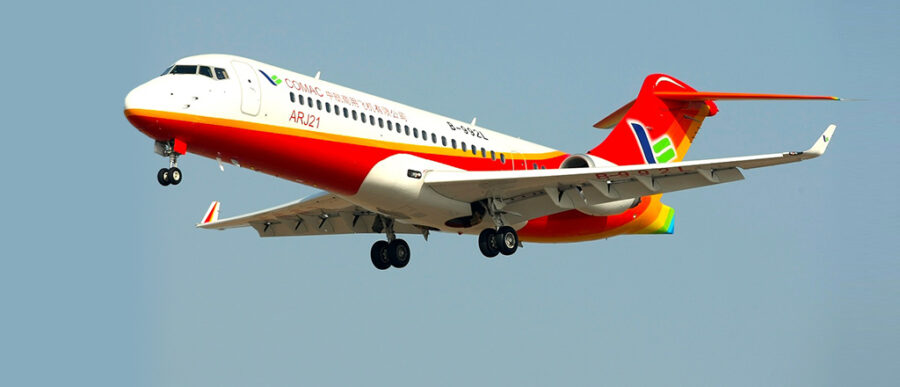On December 30, 2014, Li Jia Xiang, chief of the Civil Aviation Administration of China (CAAC), flew on a regional jet liner from Shanghai Pudong to Beijing. But this journey was no ordinary flight.
After it safely landed in Beijing Airport, the jetliner, an ARJ21, had finally earned its Type Certificate from CAAC, which meant the aircraft model had satisfied its basic safety requirements and could enter China’s civil aviation market. It took the ARJ21 — the first commercially available aircraft ever designed in China — six long years to get this entry ticket.
Luo Ronghuai, deputy general manager of the Commercial Aircraft Corporation of China (COMAC) and the chief of the ARJ21 Project, has been deeply involved in the whole process — from design and R&D through manufacturing to flight testing.
What challenges has ARJ21 gone through? Are these made-in-China aircraft safe enough? Who will purchase them? What is the status of China’s second foray into aircraft design, the larger C919? And what impact have these domestically designed and built aircraft on the upstream and downstream industry value chain? China Knowledge at Wharton talked with Luo Ronghuai recently about these questions and others.
Below is an edited version of the interview.
China Knowledge at Wharton: Let’s talk first about ARJ21 in detail. What does the plane look like, and what are the aircraft it will be competing with primarily in the global market?
Luo Rong Huai: The ARJ21 jet is a 70- to 90-seat, short-to-medium range, turbofan powered regional aircraft. It’s the first civil aircraft to which China owns independent intellectual property rights, and it’s also the first time the U.S. Federal Aviation Administration has agreed to accept and approve aircraft applications for flight certification based on the reviews of the Civil Aviation Administration of China.
Its major competition in the world will be [the Embraer] ERJ175 of Brazil and [the Sukhoi Superjet 100] SSJ from Russia, both regional aircraft with 70 to 110 seats.
“Since it was the first time China had designed an aircraft, we had no experience, so there were many experiments. We had to try again and again in order to get the results we wanted.”
China Knowledge at Wharton: The ARJ21 jet liner accomplished its first flight in November 2008. Why did take so long — six years — to obtain its certification?
Luo: Since it was the first time China had designed an aircraft, we had no experience, so there were many experiments. We had to try again and again in order to get the results we wanted. After the ARJ21’s first flight in 2008, we originally anticipated it would take at most four years to get the aircraft certified – but then the real challenges began emerging, many more of them than we had been able to imagine.
It took us a long time to study, explore and learn what we needed to know to meet all those certification requirements. For example, there’s an experiment called the “Natural Icing Flight Test” which originally was planned to take place in Xinjiang province [the region in the Northwest corner of China]. However, after flying the aircraft there repeatedly over a period of four years, we had still only completed part of that testing regimen. Finally, we had to look for suitable weather conditions in North America instead.
In order to finish all the flight tests of the ARJ21, for six years, we took the aircraft to the most extreme ends of China: The furthest north, the deepest south, the coldest, the hottest, the windiest and the most humid places in the country. And, we went to the U.S. and Canada to find extremely icy environments – the plan flew all around the Northern Hemisphere.
In addition to the enormous amount of time and resources we spent on overcoming technical barriers, we also gradually built up, for the first time, a team of testing and certification staff. But we’re still small. In Seattle, Boeing has a team of more than 250 people that work on flight test certification. Our Shanghai certification center has only 50 to 60 people, and the CAAC has another 30 to 40 people.
China Knowledge at Wharton: What are these flight tests? Can you give some examples?
Luo: The major target of flight tests is to look at the most dangerous potential moments of the flight, and see how your aircraft performs — for example, a stall, passing through a 27-knot crosswind, or an engine failure, to name a few. Test pilots have to proactively seek out these low-probability events, which only happen once in tens of thousands of hours of flying time.
For example, there’s the “one engine inoperative” test, which refers, unsurprisingly, to a situation when one of the plane’s two engines isn’t working. So, you have to have test pilots shut down an engine in mid-flight to find out if the plane can be flown acceptably in that condition. But that’s only one of many, and these mandatory experiments take thousands of test flights. Only when you have tried to fly a plane under every dangerous condition you could anticipate, and proved that it can handle them, can the aircraft be considered safe to sell and fly commercially.
The type certification we took the ARJ21 through involved testing thousands of individual items. In the end, it added up to 3,418 reports and 300,000 pages, which, if you stacked them up, would be 30 meters high.
Although it was a long process, we have accumulated a lot of valuable experience for future aircraft tests. Having gone through this will make it easier and more efficient when we have to start putting our next aircraft, the large C919, through all these experiments in near future.
“The ARJ21 is the first regional aircraft China has produced based on international standards, and that it has been certified is a milestone for China’s aviation industry.”
China Knowledge at Wharton: What does this certification mean? What impact will it have for Chinese-made planes in future?
Luo: The ARJ21 is the first regional aircraft China has produced based on international standards, and that it has been certified is a milestone for China’s aviation industry. It demonstrates that we’ve successful developed our regional aircraft manufacturing technology.
The global aviation community recognizes the maturity of a country’s aviation industry by its ability to produce new aircraft that can be certified flightworthy. In the ARJ21-700 project, we have accomplished the entire process — from design to manufacturing, experimentation to flight tests. We mastered a bunch of new technology, new materials, new processes, and accumulated a lot of project-management experience, which has also laid the groundwork for future big aircraft projects like the C919.
China Knowledge at Wharton: Does this certification mean the plane can be delivered right away? Can the aircraft be exported to global markets like Europe and U.S. now?
Luo: Certification and delivery are two very different things. Every plane to be delivered to an airline has to obtain its own airworthiness certificate from the CAAC. At present, the CAAC is checking the first ARJ21-700 plane for this certificate. And the CAAC still has to audit and approve the quality-assurance system, the flight support system, and the continuous airworthiness program. Once all these checks have been done, the first ARJ21-700 plane will be delivered to Chengdu Airline [one of China’s domestic airlines] and formally start to fly, which we anticipate will happen this year.
For any airplane model to be exported to Europe and the U.S., it has to get the approval from local aviation authorities. For example, the FAA has to approve your plane if you want to sell it or fly it in the U.S. While we were working to get the ARJ21 its CAAC certification in China, the FAA conducted a shadow audit, which was mainly to examine the certification ability and methodology of the CAAC.
In that shadow audit, FAA selectively examined some items, like the natural icing flight test, the static original equipment manufacturer test, the maximum brake energy test, VMU test, etc., and sent staff to follow and examine the whole process of test basics, test guideline, methodologies, experiments, equipments and the result. After the ARJ21 got certification in China, the shadow certification also finished, and they will start another audit on recognition.
However, in some countries in Southeast Asia and Africa, certifications issued by CAAC are recognized locally, which means that Chinese-made and certified aircraft can fly in those countries.
China Knowledge at Wharton: After certification, what will you have to do next in terms of commercial efforts? And how long do you expect it will to recoup the high costs invested in this project?
Luo: Aircraft production is an industry with massive investment, high risks, and slow returns. It’s a long journey from experiments in labs to formally producing a plane, and after that to win a piece of the aircraft market. And it can take years beyond to achieve commercial success.
At present, we’ve received 308 orders for the ARJ21. After the delivery of the first one, COMAC hopes to quickly reach an annual output of 15 aircraft, and, longer term, to increase that to 50 planes a year.
For the ARJ21, we set three goals: The first one was technical success, which was met when we obtained type certification. The second one was market success: producing the aircraft with cost controls, commercial value and earning brand recognition in the market — and then winning a certain market share. The third one was commercial success: selling aircraft that are competitive in the marketplace, and that can bring economic benefits for airline companies. At this moment, we have a long way to go before we hit goals two and three.
China Knowledge at Wharton: You mentioned that it takes a great deal of money to build a new aircraft, and that the returns are slow. Given that, why should China still try to get into this industry? Also, what percentage of this project involves independently developed Chinese technology?
“Aircraft production is an industry with massive investment, high risks, and slow returns. It’s a long journey from experiments in labs to formally producing a plane, and after that to win a piece of the aircraft market.”
Luo: To make our own aircraft will activate many upstream and downstream industries in areas such as materials production and high-end equipment manufacturing. We can also gradually build up a base of local suppliers in related industries, which is suitable in the context of the current stage of China’s aviation market.
Regarding independent technology, for the ARJ21, our primary suppliers include four domestic ones and 19 global companies. We also have nearly 100 secondary suppliers in China. Global airplane manufacturers like Boeing don’t design engines, and they don’t make rivets either; they purchase parts from many suppliers instead. Boeing has nearly 10,000 suppliers globally for its parts. For our planes, COMAC is the general designer, and we integrate the best technology available globally into them.
However, or next plane, the large aircraft C919, which is still in development, will have a higher level of domestic involvement. There are 36 Chinese research institutions taking part in the project, as well as more than 200 Chinese companies, including 16 material suppliers and 54 potential parts suppliers. Meanwhile, 16 global suppliers, among them GE, Honeywell and CFM, have built joint ventures with domestic companies on avionics, flight controls and other airborne systems.
China Knowledge at Wharton: Can you talk a little more about the C919 and how it’s progressing?
Luo: The C919 is a 150-seat, single-channel, narrow-body aircraft, which will compete with the Boeing 737 and the Airbus 320. This is a class of aircraft that’s most in demand in China and the global civil aviation market.
So far, the C919 has finished the project demonstration phase, the demonstration of feasibilityand predevelopment, and it’s now moving into the engineering development stage. Assembly has begun on the first craft, and it’s expected that we will conduct its first flight by the end of 2015. Then, we will move into the flight-test certification process.
China’s major airlines, including China Eastern Airlines, China Southern Airlines, Hainan Airlines and some aircraft leasing companies have already ordered C919s. Huaxia Financing Leasing Co. has just signed a contract with us to purchase 20 C919s, which has boosted our client list up to 18 companies, and 450 total orders for the aircraft.



